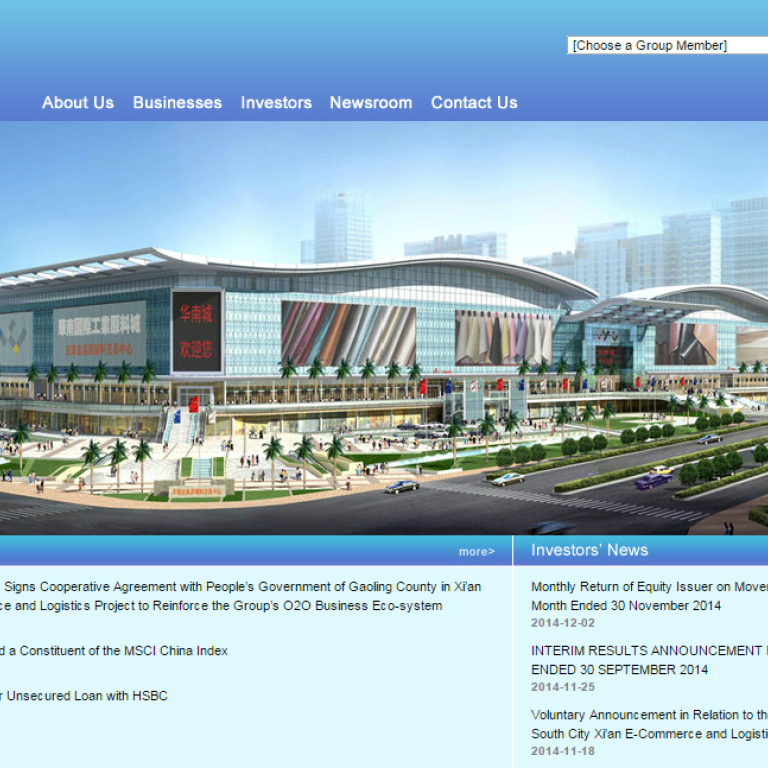
A tour of gloom and doom at China's trade centres
Shop operators lament poor business as empty stores dot China South City's facilities in Zhengzhou and Shenzhen with low visitor traffic
"There are so few visitors and I don't want to pay the rent," says Du, a shoe seller who rents a store of about 30 sqmetres in a gigantic new trade centre on the southern outskirts of Zhengzhou, the capital of Henan province.
The woman's lament sums up the problems facing many small traders in such centres, which are springing up amid a shift in the mainland's property and retail markets.
With a property downturn and an e-commerce boom that is boosting the logistics industry, many investors have been chasing logistics-related assets on the mainland.
Among them are the developers of trade centres such as China South City Holdings, which operates the Zhengzhou facility housing Du's store, and Wuzhou International Holdings.
Recent visits by the to China South City's Zhengzhou and Shenzhen projects revealed lots of empty or shuttered stores and few visitors.
The trade centres typically house wholesale space for mostly hardware sellers, retail stores for garments, shoes and lighting equipment, and some warehousing space.
Du launched an online shop selling shoes in July. But after poor sales, she rented the space in China South City's trade centre in September in the hope of reaching more consumers.
CSC Zhengzhou reported contracted sales of HK$2.78 billion in the six months to September, accounting for 40 per cent of the group's total contracted sales. About 44 per cent of the completed properties in the Zhengzhou project were sold, it said.
On the high number of closed stores, Du said some store buyers were investors while others might have shut the doors to save on staff costs with so few visitors.
"Business was so bad today. It couldn't even cover my meal expense," said Du.
It was a Saturday in December and there were already more visitors than on weekdays.
Du said the property management office had notified some tenants that it would start collecting rent in December. Before that, it had not collected rent since the centre began a trial operation in late August.
According to tenants, the management office would sign a half-year contract with tenants and give them an additional one-year rent-free period, meaning they could occupy the store for three years for one year's rent. But even such rental discounts do not seem attractive.
Luo, another shoe seller, rented two stores at CSC Zhengzhou. "I just sold two pairs of shoes today, not enough to cover the rent. If it goes on like this, I am thinking about letting out one store," he said. "This area has not been developed. Maybe three years later, things will get better."
The first phase of CSC Zhengzhou covers a gross floor area of more than a million sqmetres.
Rival Wuzhou has been building a trade centre in the west of Zhengzhou, which is expected to start next year. More than 80 per cent of phase one of the project had been sold, executive director Zhao Lidong said.
"If there was no urban redevelopment and relocation need, it would not be viable to build these trade centres," Zhao said.
The malls of CSC Shenzhen also had few visitors and many closed stores, the recent visit showed. The trade centre has been in operation since the firm's initial public offering in 2009. A major part of the third floor of a phase two mall was closed.
Phases two and three, comprising the shopping malls, had an occupancy rate of 70 per cent and 56 per cent at the end of September, the company said. Phase one, for the hardware wholesale market, had an occupancy rate of 95 per cent.
Stephen Fung, chief financial officer of China South City, said the firm planned to improve the poor visitor flow through cooperation with Tencent Holdings to develop an "online-to-offline business model". But no significant progress has been made since the two firms signed an e-commerce cooperation memorandum in June.
Bocom International analyst Toni Ho said shopping malls, especially in second and third-tier cities, were facing an oversupply, with occupancy rates of only 50 per cent at some centres.
